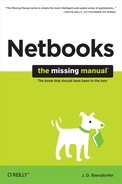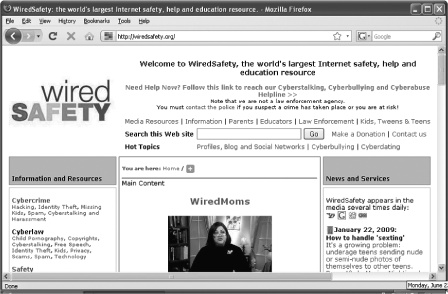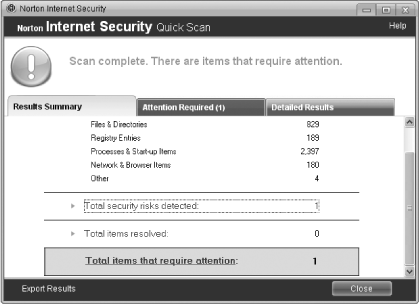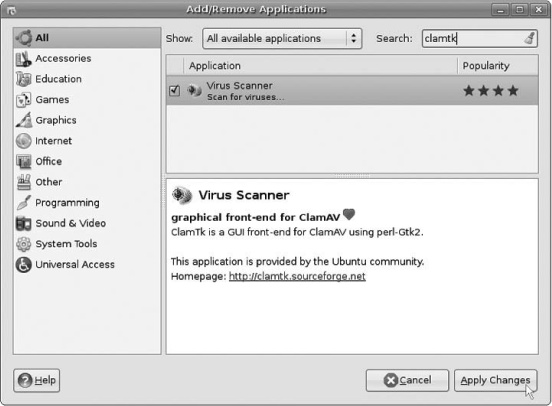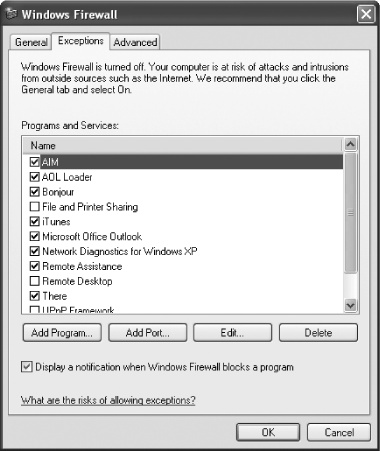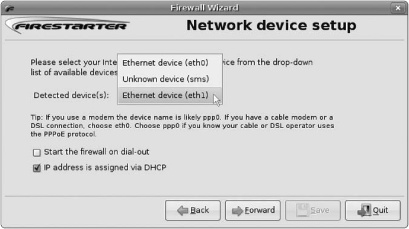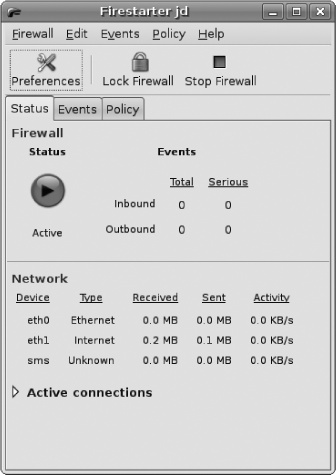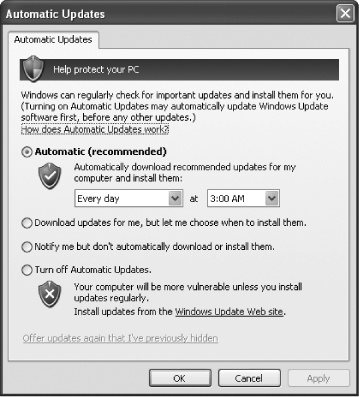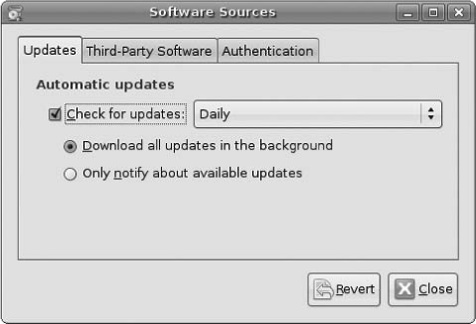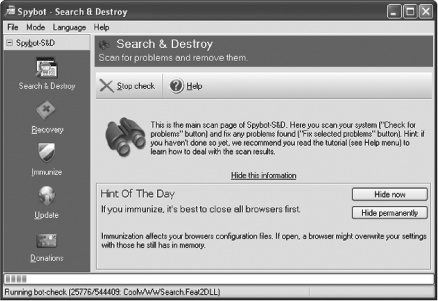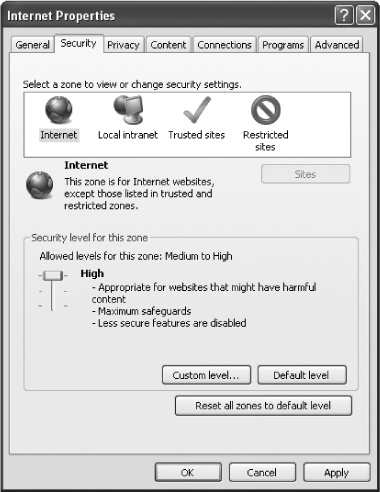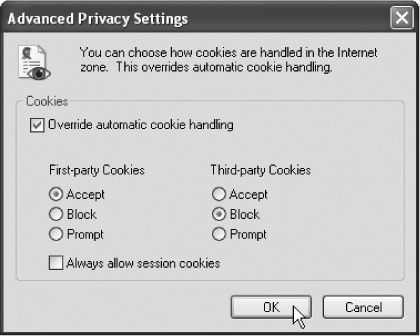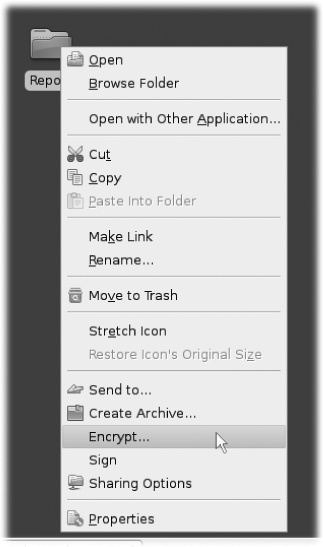Chapter 11. Protecting You and Your Netbook
The Internet can bring the world to your door—international news, long-distance education, connections with friends around the globe. It lets you discover things you would never see otherwise…like a guy demonstrating how to turn a toaster into a video game console. But where there’s good, there’s bad, and the dark side of the Internet can be very dark indeed.
You’ve seen the stories in newspapers and on TV about Internet-enabled identity theft, data theft, fraud, and a thousand and one other scams. Saboteurs turn home computers into zombie slaves and force them to send streams of pornographic junk mail. And there’s the old-school stuff: system-crashing viruses, password-stealing programs, and garden-variety hackers swiping bank account numbers right off hard drives.
Sounds scary. Knowing what’s out there, there’s really no excuse not to take precautions for safer computing. This chapter gives you an overview of how to protect yourself (netbook included) from the evils of the Internet. Along with the right software, common sense is your best weapon: Learn how to spot the signs of a scam or virus. Knowledge, after all, is power. And a good firewall helps, too.
Ten Online Safety Tips for Netbooks
Top-ten lists are a dime a…er, dozen. The following are general suggestions everyone should know for staying safe online.
Use security software. Windows computers are a huge target for malicious software. Protection programs may drag down your netbook’s speed, but installing the holy trinity—antivirus software, a firewall, and a spyware stomper—is often your first line of technical defense against Internet threats. The next few pages discuss these types of programs in more detail.
Keep your system up to date. Your system software was probably set up for automatic updates out of the box, but check your security settings to make sure. New threats pop up every day, and you want to make sure both your operating system and security software are up-to-date against today’s problems, even if you just updated the software yesterday.
Don’t give out personal information. Identity theft is rampant and data like your Social Security number and birth date—not to mention credit card and bank account numbers—is what the bad people are after. Be suspicious of any email or web form, no matter how official looking, that asks you for this information. Besides, agencies like the Internal Revenue Service (who scammers often try to disguise themselves as) already have all your personal information on file anyway, taxpayer.
Pick hard passwords. Using your spouse’s name, or worse yet, the word “password” as your password, isn’t an effective way to protect your online-banking account. A better password is a complex string of lowercase letters, capital letters, and numbers. After all, minnesota is going to be a lot easier for a hacker’s password-cracking software to guess than M1nnes0t@. Better still, change your passwords regularly.
Stay informed. Your antivirus company’s website can be very informative, with news and alerts about current threats. Visit the site regularly to keep on top of what’s going on in the world of malware. Although deeply geeky, the U.S. Computer Emergency Readiness Team (CERT) site is also a great resource, with RSS feeds and mailing lists available to bring the latest news right to you. Sign up at www.us-cert.gov.
Keep an eye on your kids. Netbooks can make great inexpensive laptops for children, who may find the tiny keyboards just the right size. But kids can still get into big trouble on little computers. Just as kids shouldn’t talk to strangers in real life, they should avoid them online as well, whether by instant message, email, Facebook, or Skype phone call (Making Phone Calls with Skype). The Wired Safety site is a valuable resource for protective parents: http://wiredsafety.org.
Be wary of public wireless networks. Sure, free Internet is great, but be wary of doing deeply confidential or personal work while connected to a public or unfamiliar wireless network. When your data is flying back and forth over the radio waves on an unsecure network, evildoers can intercept it. You may not even be connected to a legitimate wireless hotspot: That network called Free Bookstore WiFi may belong to a hacker who’s ready to gobble up your personal information. If you’re doing official company work on your netbook, ask your tech guru or systems administrator about access through a virtual private network (VPN). By using a VPN, you can connect to a private network (like the one in your office) through a public network—but stay more secure.
Email is full of spam and scams. Yes, it’s a great communications tool, but, sadly, most email messages clogging up the Internet’s pathways are from people trying to set you up or rip you off. Unwanted junk mail can also carry worms and viruses. Email addresses are easy to fake, so beware of pleas for money even from people you know. And tell your well-meaning pals to stop forwarding virus warnings. Most of those are all fake, too, according to the hoax-stomping site Snopes.com. (http://snopes.com)
Back up your files. Even if a virus wrecks your hard drive or a power surge fries your machine, having a backup of all your important files gives you one less thing to worry about. Built-in backup has more on backup options for Windows netbooks, while External Drive Backup discusses the topic for Linux.
Know what to do if the worst happens. If someone hijacks your netbook, shut it down immediately—or at least sever its Internet access until you can clean the machine. Immediately cancel compromised credit cards. If you think you’re a victim of Internet crime like fraud or identity theft, you can turn to a whole page of government resources at www.usa.gov/Citizen/Topics/Internet_Fraud.shtml, from another machine, of course.
Keeping Viruses at Bay
Security software—especially if you’re using a Windows-based netbook—has become a necessity. Hundreds of thousands of computer viruses, worms, Trojan horses, and other bits of malicious software are cruising the Internet, waiting for vulnerable machines to infest. And they’re not just Internet pranks written by malcontented computer-science majors, either. Professional programmers working for international criminal organizations are constantly coming up with new malware with the sole purpose of stealing your personal information.
Fortunately, protection software is easy to find. Since Windows is the malware writer’s biggest target, it also has the most security software to choose from. And while Linux has been much less of a target so far, that may change. Using a basic antivirus program can help stop the spread of viruses inadvertently passed on by Windows computers.
Note
You may see antivirus programs bundled with security suites by many companies. A security suite usually includes antivirus protection, an antispyware program, and firewall software—and often other tools like spam filters and privacy protection. Security suites cost a bit more than a plain antivirus program, but offer more all-around protection.
Windows
A rumor once went around that netbooks were too feeble and underpowered to run security software. While it’s true that the Intel Atom or VIA C7 processors aren’t quite as robust compared to say, an Intel Core i7 processor revving under the hood of a desktop machine, netbook processors are more than capable of running antivirus and other protective software.
One of the reasons for the netbooks-can’t-run-AV rumor was security software’s well-earned reputation for hogging up system resources. Some security suites were so bloated, they dragged down the performance of even the most high-powered machines. Recently, though, security software companies got the message and made their programs more compact and efficient.
Your netbook may come with a trial version of an antivirus program like Symantec’s Norton Anti-Virus 2009 (www.symantec.com). Remember, since new viruses appear every day, it’s important to update your antivirus software frequently. If you like the software that came with your netbook, fine. If not, don’t hesitate to find one that you like enough to use regularly.
Note
Commercial programs typically include an automatic update feature, so the program checks back with its maker to snag the new files it needs—often called virus signatures or virus definitions—to protect the system from fresh evil. When you buy the program (or get it on your netbook), you usually get a free subscription for one year’s worth of updates. After three months or so, that trial version starts nagging you to pay to “renew your subscription.”
Most companies offer free trial versions of their programs by download so you can see how they get along with your netbook. You can also find free antivirus programs that may not update themselves as frequently, but they’re still better than nothing.
When shopping for an antivirus product, check to see if it comes in a netbook edition. Suites like Kaspersky Security for Ultra Portables ($40 at www.kaspersky.com) were designed especially for small computers.
Other lightweight guard dogs include:
Panda Security Cloud Antivirus. Panda Security claims to be the first to offer online virus-scanning and protection. A small local file keeps tabs on your netbook even if you’re not online, but the software works mostly from Panda’s servers, which frees up your netbook’s time and memory. (www.cloudantivirus.com)
Sunbelt VIPRE Antivirus + Antispyware. This $30 suite promises to protect your netbook from many kinds of malicious software—while not dragging down the machine’s performance. Judge for yourself with the free 15-day-trial version, available to download (along with the full version) on the company’s website. (www.sunbeltsoftware.com)
AVG Anti-Virus Free Edition. Offering basic protection from viruses and spyware, AVG Technologies’ free software also blocks malware on infected web pages. If you pay $35 to upgrade to AVG Anti-Virus Pro, you also get protection from malware invading through an instant-message session, a firewall, a spam filter, and technical support. (http://free.avg.com)
Note
Microsoft plans to release its own free security suite by the end of 2009: Microsoft Security Essentials. How well it works compared to the third-party programs remains to be seen. After all, if Microsoft had made Windows more secure to begin with, folks wouldn’t need all this antivirus software. Still, if free is the right price for you, keep an eye out for Security Essentials at www.microsoft.com.
Linux
Compared to Windows, Linux has relatively few viruses gunning for it. Some gurus pooh-pooh even installing an antivirus program on a Linux system. Others are more cautious and point out that an antivirus program on a Linux computer can at least stop the machine from passing on viruses caught from Windows machines.
If you want to install an antivirus program on your Linux netbook, ClamAV (http://clamav.org) is one that’s free and available to download from the Ubuntu software repository. Regular ClamAV is a command-line program, though, so if you don’t feel like typing a bunch of arcane stuff in the Terminal window, there’s the ClamTk program (http://clamtk.sourceforge.net) instead—ClamTk is a graphical version of ClamAV and easier for Linux newbies.
Installing and running ClamTk
To install ClamTk, choose Applications→Add/Remove and search for ClamTk. When the results come in, turn on the checkbox next to ClamTk and click Apply Changes to install it. (You can also get ClamTk or ClamAV by choosing System→Administration→Synaptic Package Manager and searching for them, although the Add/Remove feature is easier.)
After you install ClamTk, choose Applications→System Tools→Virus Scanner to run it. Just to be on the safe side, you may want to check to make sure the Clam’s list of current viruses to spot is up to date; choose Help→Update Signatures.
If you get a snotty message from Ubuntu saying you need to be logged on as root (the all-powerful user described on Adjusting the Mouse), before you can update ClamTk’s signature files, you need to do a little command-line work to get permission. Choose Accessories→Terminal. Type in gksu clamtk and hit Enter; type your Linux system password when prompted. Now, when you go back to ClamTk and choose Help→Update Signatures, you won’t get any back talk. To have ClamTk automatically quarantine any viruses it finds, choose Options→Quarantine Infected Files.
To scan the Home directory on your netbook (or just a file or folder), choose an option from ClamTk’s File menu. To thoroughly scan a folder and all its subfolders, choose File→Recursive Scan and point ClamTk to the folder in question. Deep scans may take a while, but the program’s progress bar keeps you up to date.
If ClamTk finds a virus, it lets you know about it in the Status column. If you’ve chosen to quarantine suspicious files, choose Quarantine→Maintenance to see the corralled files. If you’re not sure that a file might be a virus, look up its name on the Web or in a virus encyclopedia like http://threatinfo.trendmicro.com/vinfo/virusencyclo. If the file in question is a virus, click the Delete button. If ClamTk finds a file you know isn’t a virus, click the False Positive button so it doesn’t find the file again on your next scan.
Note
ClamAv and ClamTk aren’t your only Linux options. Panda Security (www.pandasecurity.com) and F-Prot Antivirus (www.f-prot.com) both have commercial software for Linux systems. Avast has a free Linux home edition as well; details are at http://avast.com/eng/avast-for-linux-workstation.html.
Putting Up a Firewall
With malicious software blazing across the Internet, your netbook can use even more protection, especially from people trying to connect to your computer to hijack it for their own use or swipe your personal information. “How do intruders get into my computer in the first place?” you may ask.
The answer is through ports—little pathways the operating system uses to let connected devices and Internet programs speak to your netbook. Many programs that do business online (web browsers, multiplayer video games, email programs, and so on) use a specific port. But someone who knows how ports work can find an open one and slip in software to take control of your computer.
You can protect your netbook with a security barrier called a firewall. A firewall monitors your computer’s ports and stops unauthorized programs from getting into your system—or sending information out from it. Firewalls come in two different flavors: hardware firewalls and firewall software programs.
Hardware firewalls are boxes that go between your computer and your Internet connection. You may already be using one and not know it—many network routers also double as hardware firewalls to shield the network from prying eyes. If your home network router uses network access translation (NAT), you already have a dandy firewall. NAT technology allows connections from your computer but doesn’t allow other computers on a different network to connect to yours. (You can read about NAT in detail at http://computer.howstuffworks.com/nat.htm.)
Software firewalls, on the other hand, are programs you configure to block unwanted network traffic and attention. If you purchase a security suite for your Windows netbook, you may get a personal firewall as part of the package. If you didn’t buy a suite, you have a free basic firewall included with Windows. Ubuntu Linux also comes with firewall options.
Windows
The original edition of Windows XP had a firewall tucked inside, but it was turned off and many people couldn’t even find the darn thing to turn it on. Fortunately, from Windows XP Service Pack 2 onward, the firewall comes turned on, and it’s much easier to find. To see it, choose Start→Control Panel→Security Center. (If you’re using the Classic view of the Control Panel area, choose Start→Control Panel→Windows Firewall.)
The Security Center control panel has icons to click to open settings for the Windows Firewall, Automatic Updates (Other Security Software for Netbooks), and Internet Options—a collection of settings for your netbook’s web browser and network connections.
In the Windows Firewall control panel, you can see which programs have permission to go through the firewall by clicking the Exceptions tab. A list of programs appears. If you need to add an exception or open a port for a particular program (like a multiplayer game that needs a specific port to play through), click the Add Program or Add Port buttons to set things up—check the software’s settings guide for any ports that need opening. Microsoft has further instructions for using Windows Firewall at http://support.microsoft.com/kb/875356.
Windows Firewall is not the most intuitive software and it’s been criticized for only blocking incoming—but not outgoing—traffic. If you want a more robust gatekeeper, consider a commercial firewall program or at least a more versatile freebie like Check Point’s free version of the Zone Alarm firewall at http://bit.ly/OBr4S.
Linux
Linux was designed with security in mind and includes a firewall called IPTables tucked away deep in the system. The Ubuntu Community site has a page that explains how it works at https://help.ubuntu.com/community/IptablesHowTo, but the program is command-line driven, which may not be your thing.
A graphical-oriented program like Firestarter makes it easier to manage the firewall and its rules. To install it on Ubuntu, choose Applications→Add/Remove, search for Firestarter, and install the program as described on Adding and Removing Programs.
After you install the software, choose System→Administration→Firestarter. When you run the program for the first time, a Windows-like wizard appears on the scene to walk you through the setup procedure. The wizard will ask a few things, including:
How do you connect to the Internet? Use the pop-up menu to select your connection method, which will probably be an Ethernet device unless you’re dialing up with a telephone modem to get online.
How do you get your IP address? Every computer needs an Internet Protocol address to get on the Internet. Turn on the checkbox for “IP address is assigned via DHCP” if the netbook normally jumps onto a home network. (The eth0 connection is usually your wired Ethernet connection, while eth1 is probably your wireless connection.)
Do you share your Internet connection? Unless you’re letting someone else connect to the Internet through your computer, leave the “Enable Internet connection sharing” checkbox turned off.
When you get to the last screen, make sure the “Start firewall now” checkbox is turned on and click the Save button. Once you start the firewall, it runs quietly in the background in a secure mode.
To see Firestarter in action, choose System→Administration→Firestarter. The three-tabbed box shows you the Status (the network activity), Events (connections the firewall has blocked), and Policy (where you can set up rules for special programs that need to get through the firewall).
You may not ever need to set up any policies for programs in Firestarter, but if you do, the program has thorough documentation on how to do it at www.fs-security.com.
Other Security Software for Netbooks
Keeping your operating system up to date with the latest patches from Microsoft or Canonical (the force behind Ubuntu Linux) is another important security step, since the companies often close up security holes and make other improvements via updates to the system software. You can set each system to automatically check for updates.
In Windows XP, choose Start→Control Panel→Security Center. In the Security Center control panel, click Automatic Updates. Or, if you use the Classic view of the Control Panel, choose Start→Control Panel→Automatic Updates. In the box, you can make sure the service is turned on and pick a time each day for Windows to check back with the Microsoft mothership for any new updates. (The company tends to push out its big fixes on Patch Tuesday, which is the second Tuesday of each month.) A yellow shield in the taskbar means Windows has new updates either ready to download or currently downloading.
In Ubuntu Linux, choose System→Administration→Software Sources. Type your administrator password. Click the Updates tab, turn on the “Check for updates” checkbox, and choose Daily from the pop-up menu. Also turn on the “Download all updates in the background” checkbox. (Later versions of Ubuntu may have checkboxes for "Automatic updates,” as well as “Install security updates without confirmation.”) You can manually check for updates by clicking the yellow exclamation point icon in the top panel toolbar.
Spyware
With Windows XP, you need to be on guard for spyware. These sneaky software chunks can infiltrate your computer by being bundled with a game or program you install—or by more insidious means. Spyware can do everything from compromising your system’s security to slowing your computer to a crawl. If you’re not using a security suite that includes an antispyware program, you can find help either through a commercial program like Webroot’s SpySweeper ($30 at www.webroot.com) or through a freeware fix.
For spy-stomping on a budget, consider Spybot Search & Destroy (www.safer-networking.org), LavaSoft’s Ad-Aware Free (lavasoft.com), or Microsoft’s own Windows Defender (www.microsoft.com/defender). Once you install an antispyware program, start it and have it hunt down the unwanted software that’s invaded your netbook. You’re typically presented with a list of intruders after the program sweeps the system, with the option to delete the pests.
Browser Security
Your web browser (probably Internet Explorer or Firefox since you’re on a netbook) also has some security settings you can adjust to protect yourself better online. Among other things, you can block pop-up windows, potentially harmful web-page scripts, and unwanted cookies. The CERT site for computer security also has an in-depth list of browser security tips at www.cert.org/tech_tips/securing_browser.
Internet Explorer
Choose Tools→Internet Options and click the Security tab. Click the Internet icon and push the slider to High for maximum security. This setting may disable the features of certain websites, but makes for a safer browsing experience.
Click the Trusted Sites icon and then click the Sites button to add the addresses of websites you know and trust—ones you visit regularly, like a newspaper website. (You can set the slider to Medium security for sites you trust.)
Click the Privacy tab in the Internet options box and then click the Advanced button. This leads to the controls to block cookies, those little bits of text a website leaves with your browser. While cookies can be good (they’re why Amazon.com welcomes you back by name), they can also let villains track your movements from site to site. Blocking third-party cookies—ones that comes not from the sites you visit, but from any ad agencies working with them—can help maintain more privacy.
You can also choose to block pop-up ads by turning on the checkbox at the bottom of the Privacy tab. Internet Explorer’s Tools menu also has options to block pop-up windows and turn on a phishing filter to warn you against sites trying to phish, or dupe you into entering personal information by disguising themselves as legitimate business websites.
Firefox
To dump cookies and other personal information that may have accumulated during a surfing session, choose Tools→Clear Private Data. A box pops up with a list of personal tidbits you can dump out of Firefox’s memory, including cookies and your browsing history.
If the box doesn’t pop up, choose Tools→Options→Privacy, or Edit→Pref-erences→Privacy in Linux. In Private Data, click the Settings button to see all the things you can dump. Turn on the “Ask me before clearing private data” checkbox if you want Firefox to ask you what data to flush each time.
For extra protection from malicious scripts embedded in evildoers’ web pages, there’s a Firefox add-in called NoScript that shuts down rogue code. You can get it at http://noscript.net. Running it may hamper normal scripts on many legitimate websites, so NoScript lets you give your familiar, trusted sites permission to use their scripts with a click.
Out of the box, Firefox has pop-up window blocking turned on. It lets you know when it’s blocked a new window by displaying a message just below the browser toolbar. If you want to let the window open, click the Options button in the message bar and choose the option to allow pop-ups from that site.
Tip
If you’re entering credit card numbers or other personal information into a website, make sure it’s a secure site. Secure sites, which encrypt your data when you send it over the Web, usually have URLs that start with https:// instead of http:// and often feature a lock icon at the top or bottom of the window.
Public Wireless Network Security
With the abundance of wireless networks around airports, coffee shops, bookstores, libraries, hotels, and other places where people gather, you and your netbook are never far from the Web. But keep in mind: Not all people are nice. That polite-looking young lady working two benches over from you on the park’s free wireless network could actually be rooting around in your netbook’s hard drive. Don’t leave your security doors ajar.
Unlike your home wireless network, which you can set up with security measures and password-protection (Wireless Network Security), you don’t know who set up the public wireless network—or who else is using it at the moment. With that in mind, take the following precautions when netbooking away from home:
Make sure you’ve got a software firewall in place and that it’s turned on (Putting Up a Firewall).
Don’t type passwords for online accounts linked to credit cards or credit card numbers, and refrain from doing online banking or stock trading in public.
If you’re working on your novel or other files on your netbook’s hard drive and not using the Internet, turn off your netbook’s wireless radio (Ports of Call: Your Netbook’s Jacks). In addition to more security, you’ll gain more battery time.
If your company offers access to its private network through a secure VPN (virtual private network) service, by all means sign up for it. You can still hop onto the Internet over a public wireless network, but you’ll be safer when you do.
If you have a ton of personal files with sensitive information in them, consider encrypting them so even if the files get snagged, opening them will be difficult or impossible. TrueCrypt is a free file scrambler for Windows and Linux at www.truecrypt.org. With Ubuntu Linux, you can encrypt files in the OS, but you need to set up encryption keys and other techie stuff first; details at https://help.ubuntu.com/community/EncryptedFilesystemHowto. (To be extra safe, make sure you have an unencrypted backup of the files at home.)
Safest of all, leave the files with your personal and financial information back on your home computer and just use the netbook for casual surfing and social networking when you’re out and about.
Protecting Yourself: Ergonomic Tips
Ergonomics is technically defined as “the study of people’s efficiency in their working environment” but the term is usually used in reference to how you physically work on your computer at your desk. Are you sitting with a healthy posture or are you contorted like a yoga casualty? Can you sit up straight while you work or are your coworkers calling you “Quasimodo” behind your hunched back? Do your fingers get numb after a few minutes of typing?
With their smaller-than-average screens and keyboards, netbooks are not exactly an ergonomic dream machine. They may put less stress on your back and shoulder when toted around town, but that’s about it. If your eyes are bleary and your wrists throb after just a few minutes of using the netbook, you’re suffering from poor ergonomics. Here are a few things that might ease the pain:
If you’re going to be doing a lot of writing on the netbook, buy one with a keyboard that’s close to 100 percent full size, which usually means a screen size of at least 10 inches. Some netbooks with 9-inch screens have to shrink the keyboard down to 85 or 90 percent, which touch typists will definitely feel after a while. Investing in a folding, full-sized USB or Bluetooth keyboard to use with the netbook is another way to type more comfortably when you have a lot of writing to do. You may have to shell out $50 or more, but saving your hands from crippling pain is worth it.
If your thumb is aching from hitting cheap plastic buttons on the netbook’s trackpad, consider doing your navigation with a mouse or trackball (Adding a Basic Mouse: The Easy Way).
Using the netbook on a table gives you more places to rest your arms. A gel-based wrist-rest may help. Tilt the screen back so you can see it without hunching.
If you’re using the netbook on your lap, prop it up with a book, lap desk, or firm pillow so you’re not slouching. (But don’t use too fluffy a pillow or you may block the netbook’s air vents and cause it to overheat.)
Take frequent breaks to stretch your arms and rest your eyes.
For aching arms and fingers, try some exercises designed to help repetitive stress injuries at www.safecomputingtips.com/rsi-exercises.html.
But don’t kid yourself: If you feel chronic pain when you sit down at any computer, schedule a visit with your doctor.
